Introduction
Sebastiaan van Hijfte created 80 adorable pixel art figures back in 2012 as a set of stock video game characters. Upon seeing them, their charm, style and simplicity instantly caught my imagination and I had planned to bring them to the third dimension. And then bring them to life. And then bring them to their own worlds. As always, project scope balloons as much as it wants until I decide that four months is quite enough.
See the final video below:
In addition, I am uploading the creation of the worlds in MagicaVoxel and the animation of all the characters in Blender to the YouTube channel.
Note: I believe that these characters were later used in the Robot Loves Kitty game Legend of Dungeon, so give them some love.

Modelling the Characters
Thanks to the modern technological marvel that is MagicaVoxel (MV), modelling the characters was mostly straightforward. I sampled the colour scheme used in the characters directly into MV’s blank palette.
The main challenge here was the proportions of the human characters. Specifically, their eyes appear too far apart when there is a two-voxel gap, and too close together when they’re one voxel apart, in proportion to their heads. The workaround was to place a detached voxel in front of the figures that require it, which would then be placed at width in between the voxels of the head.
Similarly, detached voxels were placed around characters that will use particle systems, such as the beer of the dwarf, and the flames of the warlock.
When all this was done, these characters were imported into Blender for final touches, merging down duplicate vertices (MV treats voxels as separate volumes within a mesh) and correcting the placement of the eyes. The materials are simple to set up as each colour is a pixel in the UV map. Additional maps are created for the mapping of the transmission and emission channels (e.g. the flame of the warlock for emission, and the wizard’s crystal ball for transmission).
See the renders of the characters below:

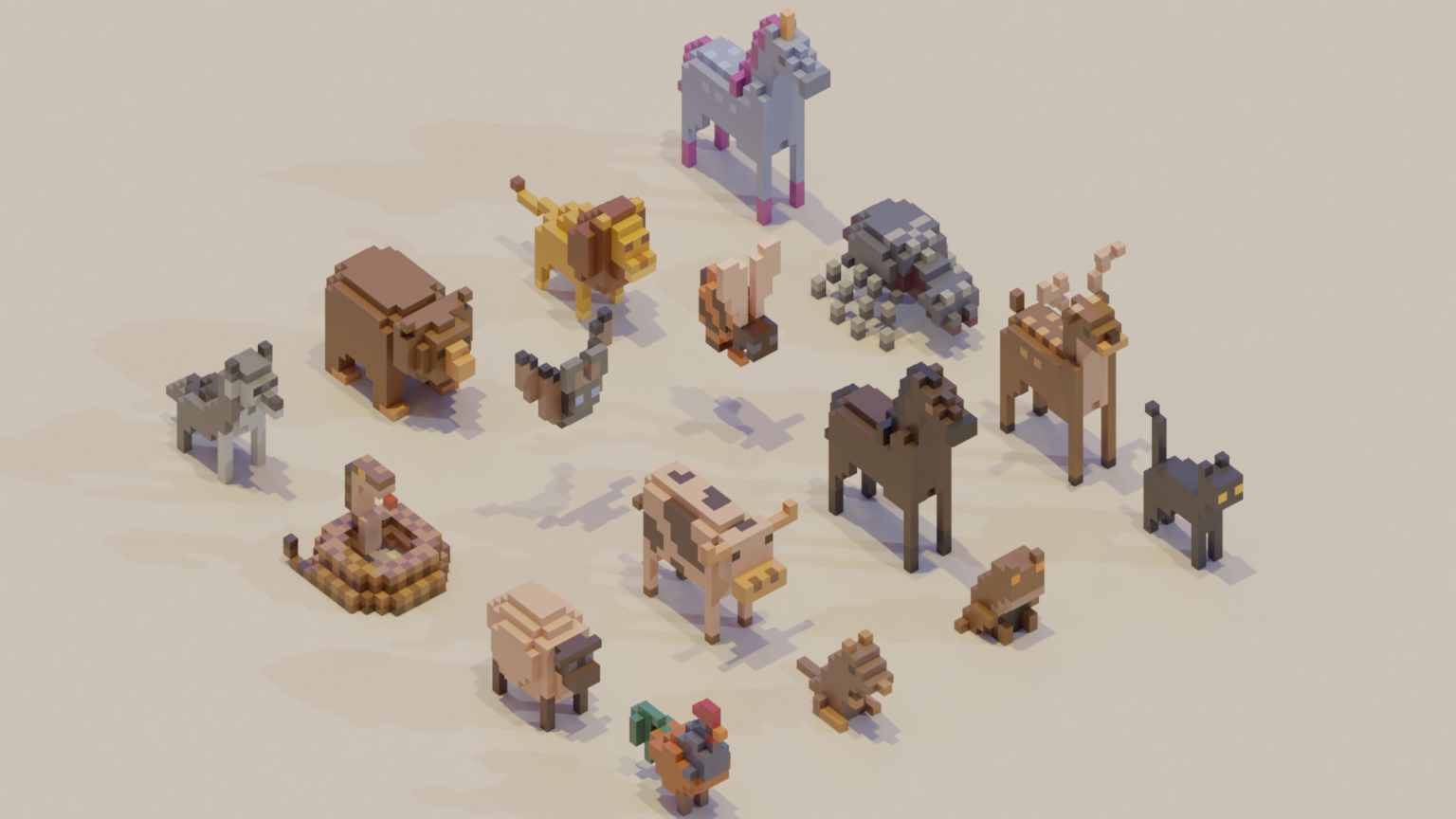



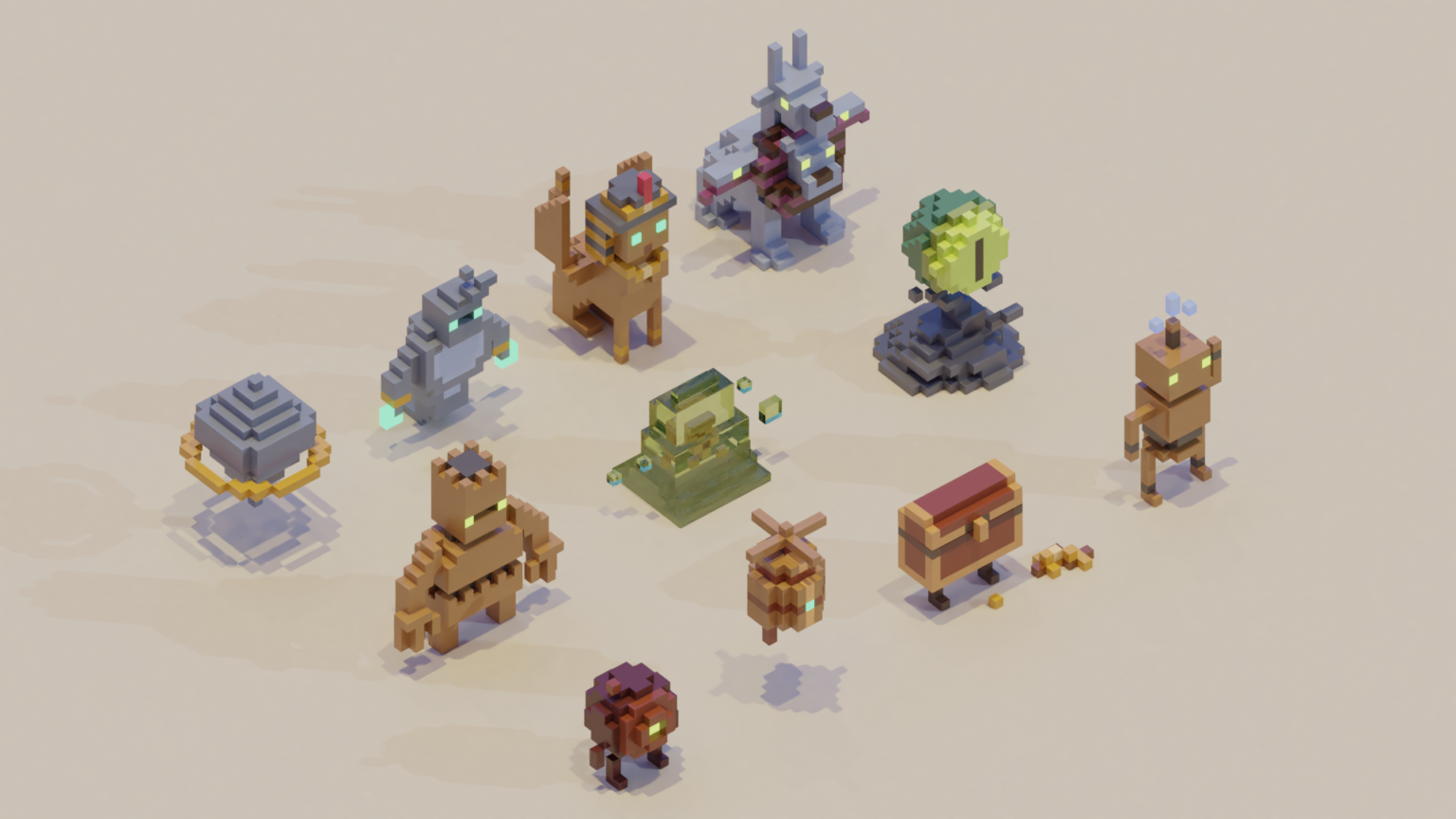
Modelling the Worlds
The characters don’t just need to be animated but live in their own worlds too. Conveniently, one of the original posters had already grouped them by theme. These themes are fantasy archetypes and fit in well with the lands of Magic: The Gathering, green for forest, blue for island, black for swamp, and red for mountain. The odd ones out are the arcane themed characters, which are a blend of mechanical contraptions, and middle eastern mythology.
Thumbnail Sketches
Once the themes were identified, thumbnail sketches of the worlds were quickly whipped up for guidance. This is where I got the idea to place “Heaven’s Farm” in between the worlds, to serve as a world for the out-of-place unicorn, seraphine, and extra farm animals.

Colour Palettes
Colours were mixed and matched from various palettes from the Lospec Pallete List which is an amazing resource.
Modelling
If there is one takeaway from modelling the worlds, it’s that when modelling in the voxel style, use boxes and straight edges, not fine detail. Even then, the size of the character models are so surprisingly large, that the worlds will have to octuple in volume (double in lengths) to be an appropriate size for the characters, and avoid a painstaking level of detail.
Forest
The gargantuan woods features most of the fauna and primal characters. Gigantism is a common theme here, with giant flowers, mushrooms, hornets, and spiders. Note the hornet’s nest and the underground glowing mushroom cave.

Cove
Poseidon’s cove is a place for all the marine themed and ancient Greek characters. It has a oxidised copper statue of its namesake and other Greek ruins. The ship was originally larger and in the form of a trireme. However, its scale and bareness didn’t fit with the overall aesthetic so this was changed to a cute miniature pirate ship. Note the kraken underneath the ship, the shipwreck, corals, and kelp to be animated.
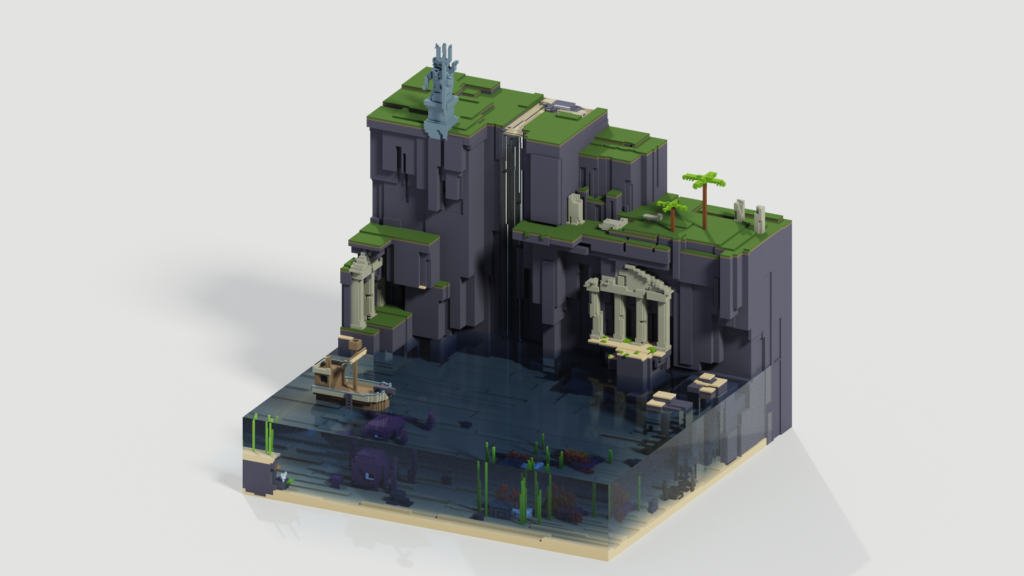
Swamp
Of course, all the undead creatures belong in the swamp, that is the site of conflict between the lich in his cave, and Dracula, hiding in his castle. The only thing separating them are the mangroves. While the lich’s cave is bare, only using it to summon the dead from the graveyard atop, Dracula’s castle is ornate with impossible geometry reminiscent of Giovanni Battista Piranesi’s Carceri, and the occasional Piet Mondrian Composition with Red Blue and Yellow.

Volcano
Mount Infernus, the gateway to the underworld and complete with the skeleton of an ancient dragon at its base. The entrance leads to a great stairway to the lava pools below, though the structures appear to be cracking and melting from the constant eruptions.
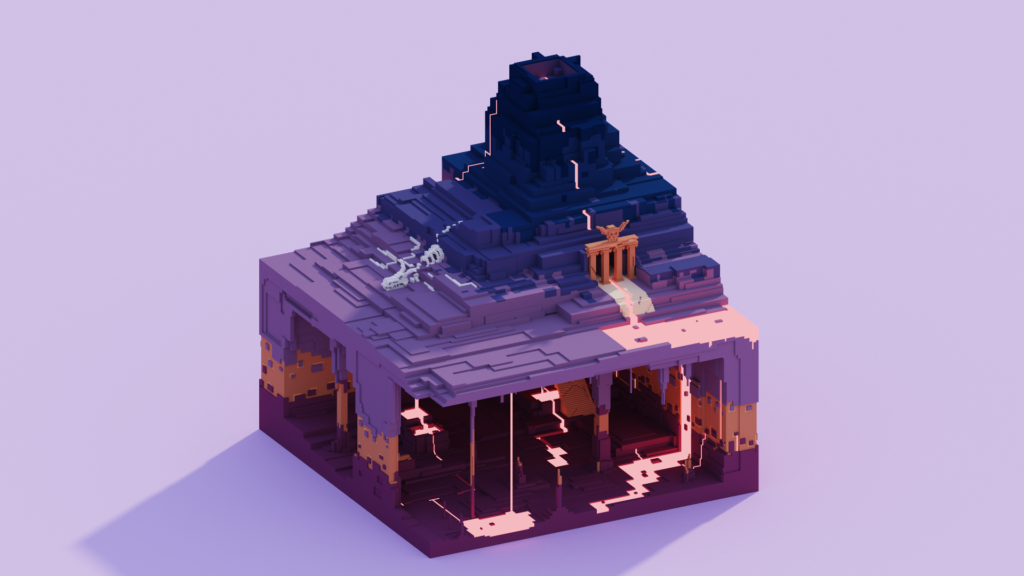
Desert
Ah, my favourite, Clockpunk Arabia. A new setting for the retrofuturist steampunk/clockpunk aesthetic. We now have a mighty, layered, intricate city with hidden factories, towering minarets, a giant genie’s lamp, and rotating gears ticking away. The city is flanked by an oasis, and a local village at the foot of a pyramid. The entrance to the pyramid is guarded by two Anubis statues, and a sphinx atop, protecting the sarcophagus inside.
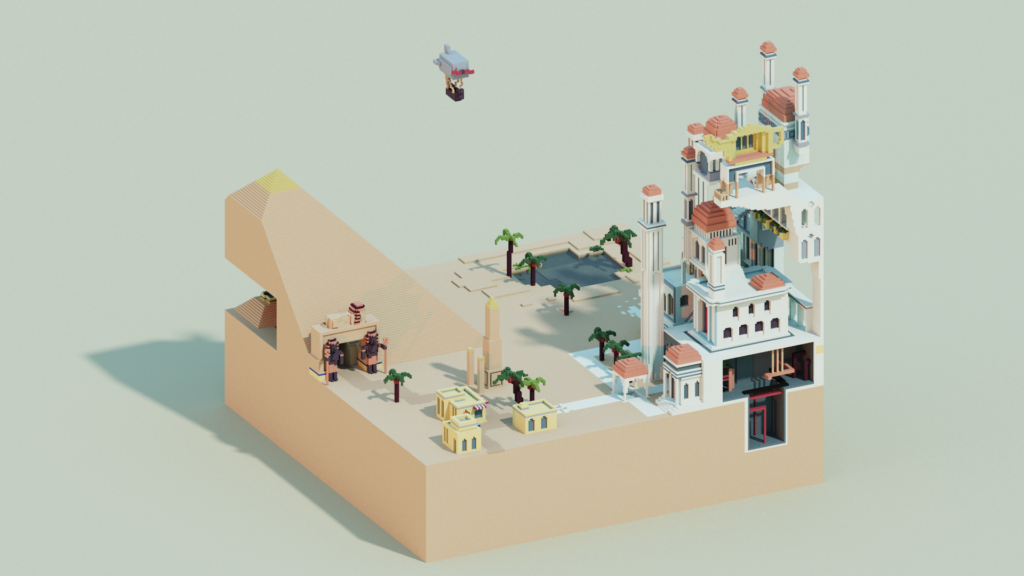
Likewise, the worlds are imported into Blender for merging duplicated vertices, scaling up, and separation of the water bodies form the rest of the model, as they will need to be a different material with their own animation.
Animating the Characters
Throughout the modelling process, I kept a list of “features” that I will be including in the worlds. That is to say, the features are how the characters will be animated and interact with each other. The approach was to pair off most of the characters so I would have to come up with 40 ideas, instead of 80. The ideas will also need to loop, generally over 3 seconds, so I needn’t worry about the flow of logic when rendering out these scenes.
The features of these worlds are inspired by wimmelbilderbuch pictures, which teem with life frozen in a moment of time. Similarly, this is an analogue of those picture books with a richly populated world on a loop.
Rigging
Most of the characters were rigged with simple armatures, with jointing avoided were possible. The aesthetic of pixel/voxel art is that it is rough, so the animations need not be refined. For example, the spider is only rigged with four legs, instead of eight.
List of Features
Gargantuan Woods
- Chicken chasing the gourmet, poetic justice
- Marksman standing on the back of a centaur, shooting arrows everywhere
- Pair of hornets (zingers?) harassing a spider
- Dryad riding the top of a treant
- Druid raising an army of fungants out of the ground
- Savage trying to scare off a grizzly bear waiting for him at the base of the tree
- Deer fighting off a pack of wolves
Poseidon’s Cove
- Ogre chopping down a palm tree that the monk is hopping around on
- Minotaur sending cows to their barn after they pop out of Super Mario pipes
- Executor and cyclops in a tussle
- Dwarfs attacking a troll, only to be clubbed back into their fortress
- Merchant making an evil deal with Mephisto
- Artist signing to charm a snake
- Corsair playing baseball with a mermaid using the ship’s cannon
Swamp of the Undead
- Zombies falling off the edge of the world, due to a cheeky reaper
- Warlock exploring the lich’s lair using a will o’ wisp to light the way
- The lich summoning his skeleton army
- Toads jumping on the heads of bogbeasts and a blight
- Gelatine zipping around the mangrove
- Grim warrior army ready to storm the castle, with their leader riding a nightmare
- Bloated zombie knocking down the door
- Death claw, phantom, and gloom lurking inside the castle
- Priest duking it out with the vampire
- Feline bouncing about on the castle ramparts
Mount Infernus
- Paladin quite persistent with a mimic
- Succubus riding an embersteed around the volcano
- Cerberus (Kerberos) barking at a rat that crossed the entrance way
- Devil fishing imps out of the lava and feeding them to the glutton
- Tormentors floating around whilst ifrit jumps in between lava pools
- Soldier caught in a fight with a Gorgon, turning him to stone periodically
Clockpunk Arabia
- Mechanics tinkering with drones on a production line and an automaton
- Floating eye patrolling the city
- Golem getting scared off the back of a horse by a sphinx
- Goblins bombing open the sarcophagus of a sleeping mummy
- Wizard transforming a lion into a chimaera and back again
- Assassin jumping out of an airship, only to be teleported back by a prism
- Genie (djinn) floating in and out of his lamp-house
Finally, the heavenly world in between hosts all the sheep, seraphines, and the unicorn seen at the start of the video. The Polysthetic statue is on its own cloud with a banner hoisted by two of the Seraphines.
Animating the Worlds
Animations of the worlds were kept simple:
- Trees were animated by painting them as vertex groups and applying a wind modifier to the worlds
- The waters of the cove and forest were animated by adding a keyframe driver on the transform nodes to move a noise texture, simulating waves and ripples
- Particle systems were used to simulate the volcano eruption and flowing lava, and the waterfall in the cove
- Rotating gears were use in Arabia to seal the clockpunk theme
Lighting and Rendering
A sunset HDRI was used for colour, with a main sun light source. In addition, each world also had its own coloured spotlight to give each world its own atmosphere.
Rendering was also kept simple, with slight depth of field in the camera, and glare added in the compositor.
Music
Each of the worlds have their own music track that play when they’re the focus of the video. The tracks are kept short ranging from 32 to 36 bars.
Gargantuan Woods
Key of A Major, 108 BPM
Inspirations: Fairytale TV theme from Gex 3
Timbres: pizzicato, string section, woodwind section, bass guitar, popcorn-like synth, ambient synth loop, reversed cymbal
The Fairytale TV theme is a heavy inspiration for this piece, so much so that the first thing I did was transcribe one of the melodies in the original which is used here in the second section, following the bridge. The rest of the track has a tribal feel crossed with simple orchestration.
Poseidon’s Cove
Key of B Natural and Hungarian Minor, 115 BPM
Inspirations: Mythology Network theme from Gex 3
Timbres: acoustic guitar, synth pads, bass guitar
A mixture of underwater level game music using synth arpeggio pads drenched in reverb, with an attempted Greek twist. Gex 3’s music nailed it with the bouzoukis, but I could never manage to find a good sample of the instrument or a soundfont. I instead used acoustic guitar with flam and a volume LFO to simulate the strumming of the instrument.
Swamp of the Undead
Key of Eb Phyrgian, 120 BPM
Inspirations: Kids See Ghosts – Kids See Ghosts
Timbres: various synths, bass guitar, xylophone, owl hoot sample, trumpet
Kids See Ghosts was a major inspiration for this track, namely the melodic percussion and the eerie, vibrating synth phrases in the background. Xylophones play the melody in the second sections as they are always associated with skeletons. Finally, an owl hooting periodically seals the atmosphere.
Mount Infernus
Key of A Minor, 100 BPM
Inspirations: Maximo: Ghosts to Glory’s Graveyard Area Music 1, Dino Run’s Volcano Theme
Timbres: string section, bongos, organ, distorted electric guitar, organ, recorder
Maximo’s haunting ascending string bass line is memorable years after I played the game, so set the bass line for this track. In addition, I stumbled on Dino Run’s awesome volcano level music which features a highly distorted atmosphere, a pounding rhythm, and a recorder over the top. Thus, I used an electric guitar as a pad for this track, with melodies played with a recorder. The track is finished with some tribal percussion for the volcano setting, and an organ for the hellish world underneath.
Clockpunk Arabia
Key of C with an approximate Rast maqam (i.e. C major with a E and B flattened by a quarter tone), and a Hijaz Kar maqam for the B-section (equivalent to a double harmonic major or Byzantine scale), 100 BPM
Inspirations: Hedwig’s Theme – John Williams, various Arabic music I’ve listened to over the years
Timbres: darbuka, claps, tambourine, flute, string section, xylophone, qanun (big thanks to Dr. Oz for the amazing soundfont), bass guitar, samples of a bell, ticking clock, and cuckoo chime
The Arabic sound was fairly easy to emulate with the appropriate instruments, and the particular modes (maqams) used. All that’s left was to seal the other half of the theme, which was done with samples of chiming bells, cuckoo clocks, second hand ticks, and accompanying melodies played with a xylophone.
